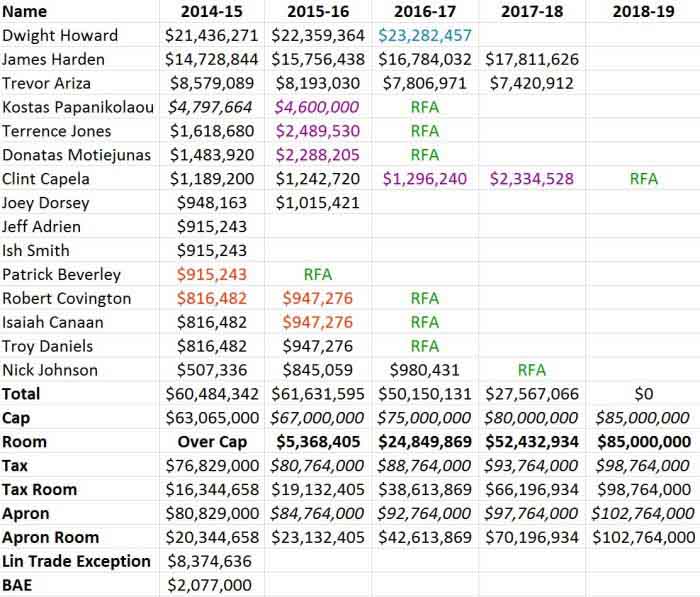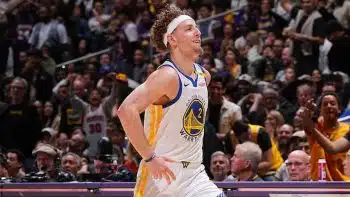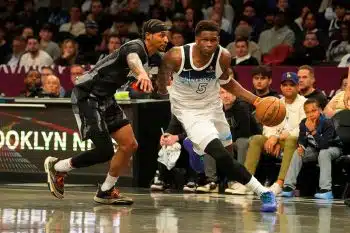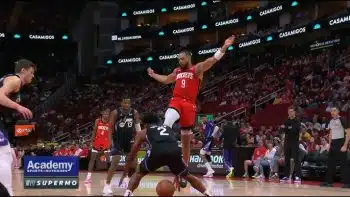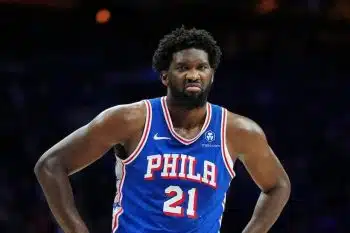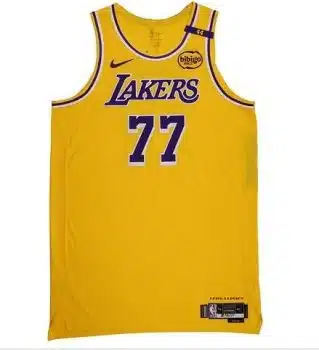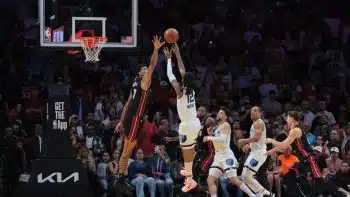NBA
The Rockets’ Decision to Let Chandler Parsons Go
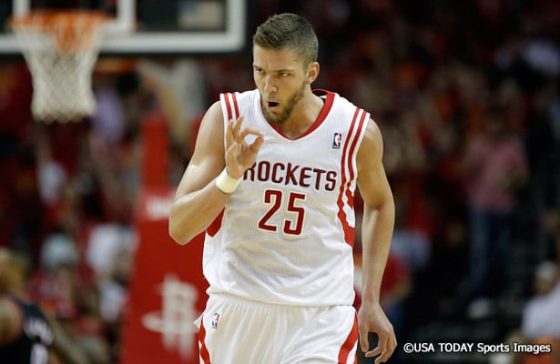
We will likely never know the Dallas Mavericks’ true motivation* when they signed Chandler Parsons to a three-year, $46.1 million offer sheet on July 10. How much did they want Parsons, and how much did they want to torpedo the best-laid plans of Houston Rockets general manager Daryl Morey? At the time, Houston was the beneficiary of Parsons’ relatively low cap hold and the fact that it held his Bird rights. Houston’s plan was to use salary cap space to sign additional players and reach the salary cap, then use Parsons’ Bird rights to exceed the cap for his contract. By signing Parsons to the offer sheet, Dallas put a three day clock on the Rockets’ ability to use their cap space–if they planned to retain Parsons. Once the Rockets matched the offer sheet, Parsons’ $14.7 million would be on their books. If the Rockets did not use their cap space before this, it would be wiped out. With LeBron James’ indecision essentially extending the NBA’s moratorium, the Parsons offer sheet drew ever closer to the witching hour.
*Nor will we know for certain why the Rockets let Parsons out of the fourth year of his contract to become a restricted free agent to begin with. Speculation is that Parsons’ agent, the powerful Dan Fegan, secured the Rockets’ agreement to let Parsons out of his contract as part of the price for Dwight Howard signing in Houston a year earlier, although no one has actually be able to confirm that was the case.
But when James decided to sign with Cleveland on July 12, it appeared the stars were aligning once again for Morey. With James leaving Miami, the signing of Chris Bosh was suddenly considered nearly fait accompli by many observers on that frenzied day. To facilitate the potential signing, the Rockets bribed the Los Angeles Lakers with a protected first-round pick to take Jeremy Lin’s $8.4 million cap number* into their cap space. But with James gone, Miami immediately increased its Bosh offer to a five-year maximum contract. Bosh agreed to it, leaving the Rockets in a lurch.
*The protections on that pick: Lottery protected in 2015, top-10 protected in 2016 and 2017, top-five protected in 2018 and 2019, top-three protected in 2020, unprotected in 2021. Part of the reason for the high price was the fact that Lin’s actual salary in 2014-15 was nearly $15 million, a result of the odd offer sheet with which the Rockets had initially poached Lin from the New York Knicks.
Now, Houston had a difficult decision on whether to match Parsons’ contract. Before getting into the particulars, it is important to assess where Houston was as a franchise. The biggest factor in all of this analysis is the ages of the players involved. Parsons will be 26 years old by the start of the season. Unlike fellow maxee Gordon Hayward (24), it is unlikely he will improve significantly throughout the life of his contract. Parsons is also an awkward fit with James Harden, who really needs more of a wing stopper next to him due to his well-publicized defensive lapses. Meanwhile, Dwight Howard turns 29 in December. Unlike someone like Shaquille O’Neal, he does not have elite size for a center. Since he is largely dependent on athleticism, Howard realistically has two years left as an elite player, and possibly only one. And while Harden is only 24, he is not someone who seems to have the greatest fitness regimen. He could well reach his prime sooner than normal as a result. Therefore, Morey’s goal should be to maximize the Rockets’ championship chances over the next two years, the only two in which a team with Harden and Howard as the two stars would be likely to compete for a championship.
The Parsons Plan
Back to the offer sheet. The structure, as with many offer sheets, was extremely unpalatable to Houston. It included a 15 percent trade bonus* and a player option for the third year. Morey called it “one of the most untradeable” contracts he has seen, and he may be right. Parsons is now wildly overpaid for a player who is probably below average as a third banana on a contending team. Moreover, even if a team believed in him enough to trade for him from the Rockets, it would have to deal with a potentially even higher salary as well as the fact he could leave almost immediately as soon as the summer of 2016.
*Relevant only if the maximum salary increases by more than Parsons’ 4.5 percent annual raises per year.
For Morey, the decision of whether to match “came down to a bet of Harden, Howard and Parsons being the final piece, because we would have had no ability to do anything after that.” Here is what the Rockets’ cap situation would have looked like after a Parsons match and some other assumed moves, such as the recently announced signing of draftee Kostas Papanikolaou to most of the mid-level exception.*
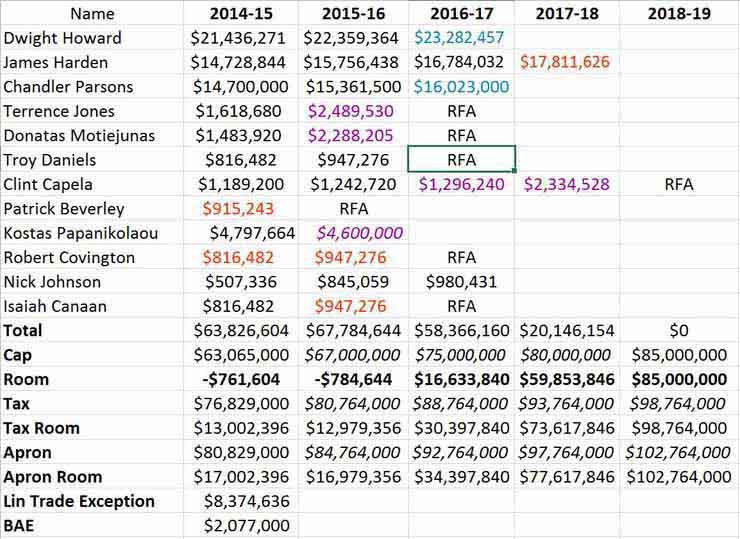
*Note that figures in italics are based on assumptions, including the future cap numbers.It is unclear exactly how much the cap will go up based on the new national television deal in 2016-17, new local TV deals and overall rising revenue league-wide. The owners may also attempt to limit the shock to the system by slowly ramping up the increases in TV money over the life of the deal rather than having it implemented all at once. Nevertheless, $75 million seems a conservative estimate for the increase in the cap by that year. Also the trade of Omer Asik for Trevor Ariza, while it technically could still have been made, would not have happened if Parsons had been kept.
As the Rockets retained their top three players, that team would have looked a lot like last year’s team. Papanikolaou* projects as a physical, high-effort defender (if not a lockdown guy) who can knock down threes. The hope is that he will be a superior backup wing to anyone else on the roster last year, and that he can also enable the Rockets to play smallball with a third wing who is actually good. The Rockets would have retained the $2 million Bi-Annual Exception (for which they have yet to find a taker), as well as the $8.4 million Lin trade exception through next summer. They could also likely count on improvement from Terrence Jones in his third year. Since the team ranked fourth in offense and 12th in defense last year, one could argue that incremental improvements might be sufficient to put Houston right in the Western Conference mix.
*It is possible that the Rockets might have succeeded in paying Papanikolaou less in the first year by guaranteeing more money later on, which they were unwilling to do to preserve 2015 cap flexibility in the current scenario.
That said, the loss of Lin and Omer Asik would really hurt the depth, as there are no proven backup point guards or centers on the roster right now. If Patrick Beverley were to get injured again or Howard misses time, the Rockets would be in trouble. All told, it seems like the team would be about as good as last year, unless it could acquire another point guard or big man with the Lin trade exception during the season. Given the team’s first-round loss and complete inability to stop Portland* in the playoffs, it is hard to see the Rockets in the same league as the San Antonio Spurs, Oklahoma City Thunder or Los Angeles Clippers in the West.
*One possible upgrade Houston apparently has not explored is at coach, where Kevin McHale’s defense underperformed last year. With a defensive taskmaster involved, perhaps a realistic scenario would emerge in which Houston could have contended with the current core.
The problem then, as Morey sees it, is the difficulty in upgrading the team over the next two to three years with Parsons on the roster. With him untradeable in Morey’s eyes, opening up additional cap space by moving salary like in previous years would be impossible with $53 million tied up in Howard, Harden and Parsons. The Rockets would project to have middling cap space at most next summer, and even that would require dumping potentially valuable players. They might have room in the summer of 2016-17 if the cap goes up with the new TV deal, but by then two more years will be on Howard’s odometer and he will likely opt out to pursue a new contract as well. If the Rockets have not contended by then, perhaps Howard would look to go elsewhere, or require a larger contract than Houston were willing to pay.
Aside from the fruits of the Lin trade exception, Harden, Howard and Parsons would likely be the major players on the team over the next two years if they had kept him.
The 2015 Plan
The Rockets did recover from the Parsons loss with the signing of Trevor Ariza. While he is not the passer or driver that Parsons is, Ariza provides about the same level of spotup shooting and far superior defense. One can make the argument that Ariza was a better player than Parsons a year ago, especially considering the Rockets’ desperate need for someone who can play defense on the wing. Now Ariza will likely decline this year from career-best shooting numbers, and Parsons could get slightly better. But the starting lineup might actually be superior to a year ago for Houston.
The same cannot be said about the bench though, where the unproven Isaiah Canaan replaces Lin as backup point guard and the backup centers are currently Joey Dorsey and raw draftee Clint Capela. Overall, the Rockets project to be a little worse during the regular year due to the lack of depth, especially if injuries hit. In the playoffs, however, the bench matters less. They could also acquire another player via the Lin trade exception down the stretch, assuming he were not owed too much long-term money.
Nevertheless, the team should not be that much worse than a year ago. Indeed, it is possible the Rockets could carve out an elite defense with three excellent defenders in Ariza, Beverley and Howard along with actual effort from Harden.
Meanwhile, this is the Rockets’ current cap forecast after letting Parsons go.
The Rockets only have a nominal $5.3 million in cap space for next summer, but that becomes $10 million if they waive or trade the non-guaranteed Papanikolaou. They could potentially open up another $2.3 million by declining the fourth year option for 2015-16 on Donatas Motiejunas (which would have to occur by October 31, 2014), leaving an approximate $12 million in space. Beverley will be a restricted free agent after his third year and will command a healthy raise as a restricted free agent, but his qualifying number will be low enough to enable the Rockets to add more salary first before he is re-signed.
The real trump card for the Rockets is a potential trade of the newly-signed Ariza. His contract starts at a hefty $8.6 million, but declines each year to $7.4 million in 2017-18. That is not a great contract considering Ariza will be 32 during the last year of it, but it is not immovable considering the rising cap and the scarcity of two-way wings. Assuming he does not have a disastrous year, trading him without a sweetener could be possible. And were one required the Rockets have adequate assets in hand, including a first-rounder from New Orleans in the Asik trade, Capela, Motiejunas (if his option is picked up) or even Jones if necessary to induce a team to bite.
Moving Ariza next summer would open up a potential $15 million or so in cap space to pounce on the following free agents, with potentially even more available for some of the big boys if they want to move Jones or the cap rises more than anticipated:
Here are some potential free agent targets in 2015:
Kevin Love
LaMarcus Aldridge
Luol Deng
Rudy Gay
Paul Millsap
Arron Afflalo
Jimmy Butler (RFA)
Kemba Walker (RFA)
Kenneth Faried (RFA)
Draymond Green (RFA)
Kawhi Leonard (RFA)
Not all of these players will be available, and there is no guarantee they will take the Rockets’ money if they are. But you can make the argument that all of these players are superior fits to Parsons on the Rockets’ roster, while many of them should be more cost-effective as well. And, this of course opens up the possibility of getting another star player to pair with Howard and Harden, remote though that is.
Ultimately, the choice on Parsons was between the likelihood but not certainty of a slightly higher chance of contention this year, and the chance to get a third star or a better fit than Parsons in the summer of 2015 while the Howard and Harden combination is still good enough to attract one. Morey has famously commented that high-risk transactions are required to maximize a team’s ceiling when only one of 30 teams can win the championship each year. Letting Parsons go for nothing would seem to be such a risk. But perhaps the greater risk would have been betting that Parsons would improve enough at age 26 to constitute a championship core with Howard and Harden.
